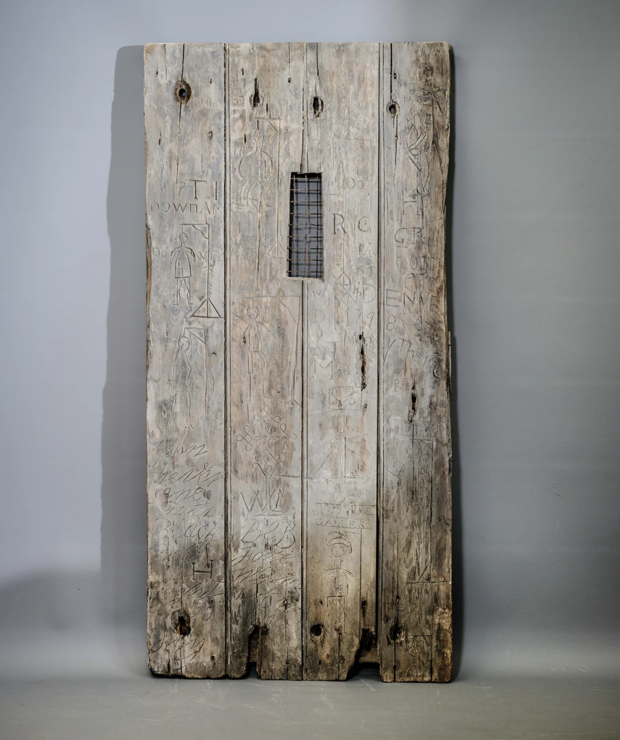Soldiers' drawings — including depiction of possible hanging of Napoleon — found on 18th century castle door
A wooden door discovered recently on the upper floor of a French Revolution-era watchtower offers an intimate look at the lives of British soldiers who spent hours at a time stationed there during the war, experts say. The door is covered in carved markings and illustrations that seem to reflect the soldiers' daily experiences, and, for the most part, they do not paint a cheerful picture.
Among several notable dates and ostensible surnames engraved into the wood are a handful of eerie drawings, in which stick figure-like people are being hanged. One of those drawings may even depict the hanging of Napoleon Bonaparte, the French emperor and military commander whose threats to invade the United Kingdom toward the end of the 18th century forced a massive British military mobilization.
Those defensive preparations in England turned out to be unnecessary because the French invasion never actually happened, and Napoleon was not hanged in the end but rather died in poor health in exile on the remote island of St. Helena in 1821. Some controversy and debate over what exactly caused his decline and death still exists today.

But, before Napoleon's exile, and amid successful military campaigns during the French Revolution, England in the 1790s began to shore up its own resources in case of a possible attack. That's when Dover Castle, a medieval fortress in Kent along the English Channel, was repurposed as a military garrison that housed thousands of soldiers, according to English Heritage, a British charity that helps manage historic sites and monuments in the country. Paul Pattison, the charity's senior properties historian, is the one who found the wooden door at the top of St. John's Tower on the Dover Castle grounds.
"Scaling a ladder to the upper floor of St John's Tower and seeing these remarkable carvings on the door was an astonishing discovery. This graffiti gives a unique glimpse into the minds of these soldiers, especially during such a charged period of time," Pattison said in a statement.
Calling the door "an extraordinary object," Pattison added that "it is a rare and precious example of the ordinary person making their mark; whether that be simply for the purpose of killing time or wanting to be remembered."
Between six to 12 soldiers stood guard around the clock at St. John's Tower, in the outer ditch around the castle, with one or two soldiers stationed at the top of the tower itself, English Heritage said. The organization suggested those men may have "put their questionable artistic talents to use" to kill time during their shifts, using knives or bayonets.

More than 50 pieces of graffiti were carved into the door, including three notable dates: 1789, the year the French Revolution began; 1798, when Dover Castle was undergoing a rebuilding; and 1855, when changes were being planned for St. John's Tower.
English Heritage said the door also contains numerous sets of initials and two surnames, a detailed carving of a single-masted sailing ship used by the British Royal Navy, a potentially religious symbol of either a wine glass or chalice with an "elaborate cross," and "at least nine gruesome illustrations of hangings." Real hangings did take place in Dover and at that time, were a form of public entertainment. But experts suggested that one of those illustrations of a man wearing a military uniform and bicorne, or two-cornered, hat could have been crafted to represent the French military leader whose wartime plans had caused such upheaval for the soldiers at Dover Castle.
The door has been removed from St. John's Tower and underwent conservation procedures ahead of its planned display at Dover Castle, now a museum, in July. It will be part of the exhibit called "Dover Castle Under Siege," English Heritage said.
- In:
- War
- Britain
- Art
- France
Emily Mae Czachor is a reporter and news editor at CBSNews.com. She covers breaking news, often focusing on crime and extreme weather. Emily Mae has previously written for outlets including the Los Angeles Times, BuzzFeed and Newsweek.
Twitter InstagramDisclaimer: The copyright of this article belongs to the original author. Reposting this article is solely for the purpose of information dissemination and does not constitute any investment advice. If there is any infringement, please contact us immediately. We will make corrections or deletions as necessary. Thank you.
Title:Soldiers' drawings — including depiction of possible hanging of Napoleon — found on 18th century castle door
Url:https://www.investsfocus.com









